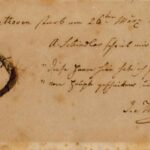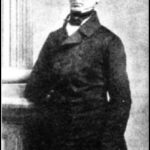One of the most distinctive features of Beethoven’s appearance was his hair. As someone from the generation of the Revolution, he refused to use wigs (although he owned at least one that he had purchased upon arriving to Vienna, as a young man), and was often described as shaggy. Over the years many locks were cut from this famous head and many of these are still preserved in private or public collections. Recently a genome study used eight of these locks. Why people cut and keep locks and what are the stories of these specific Beethoven hair locks? Let’s find out!
Why people cut and keep hair locks?
The hair of a person, throughout history, carried value. This falls into three main categories. First, it can have sentimental value. I still remember in the cabinet of my grandmother a lock of my hair was kept as a memento from my very first haircut. Secondly, it can carry superstitious value. The mentioned first haircut of a baby, for others, may mean good luck. For many it represents power over the individual, like in voodoo practices. The third category is the religious value. Roman virgins, for example, offered locks of hair to Jupiter, before getting married.
The famous hair locks of Beethoven
There are more than 30 locks today that are told or believed to come from Beethoven. These are named after the first recipients or the long term owners, not necessarily the same person who made the cut. In this article was cover only the ones that are considered authentic or relevant.
The Halm-Thayer Lock
This is the only perfectly documented lock, where the chain of custody is complete. Furthermore, this lock was handed over personally by Beethoven himself in 1826.
The lock is associated with a practical joke carried out by Beethoven’s secretary of the time, violinist Karl Holz. He was asked by Anton Halm, who at the time was completing the four-hand piano transcription of Beethoven’s Große Fuge, Op. 133, to request a lock from the great composer, for his wife. Holz in a few days handed over the lock of hair…coming from a goat!
When next time Halm visited Beethoven, he revealed that they were tricked, saying “You have been cheated with the lock of hair! You see, I am surrounded by such terrible creatures that they put aside all the respect they owe respectable people. You have the hair of a nanny-goat.” Then, he handed over a sheet of paper with significant amount of hair cut from the back. He wrote on the paper: That is my hair!
The wife was furious about the joke up until the burial of Beethoven. Holz and the Halms were standing opposite above the open grave. Holz was weeping bitterly and in shame could not look at them directly. The wife, moved by the situation, held out her hand above the grave and forgave him.
According to Schindler, known to forge history, the trick was made by Beethoven himself, but later put the blame on Holz.
This lock, together with the Bermann Lock was purchased in 2017 by the American Beethoven Society.
The Bermann Lock
The first documented owner of this lock is Mr.Bermann, who is either Jeremiah Bermann or his son, Joseph. Jeremiah married into the Eder family, a publisher of Beethoven works from as early as the 1790s. The Eders made more first editions for Beethoven, like Piano sonata Op. 10 and 13, and part of the Bagatelles Op. 119.
Bermann had direct contact with Beethoven around 1820 and 1821, although written evidence as a letter or notes in the correspondence books does not exist. In 1851 the lock was acquired by biographer Alexander Wheelock Thayer. Living descendants of Thayer in 2017 sold their collection, including the lock, to the American Beethoven Society.
The Müller Lock
This lock is connected to two individuals, Nannette Streicher and Elise Müller. Both of them had friendly relationship with Beethoven.
Nannette Streicher was a renowned piano maker in Vienna, who not only provided the composer this instrument, but helped him in other ways. In fact both she and her husband were actively helping in business and ordinary daily issues, like finding a housekeeper (a problematic area for Beethoven).
The second name, Elise Müller. She was a song composer, a pianist and a piano teacher. Beethoven and Elise were in correspondence for years and the composer even met her father Dr. Wilhelm Christian Müller, when he stayed in Vienna.
This lock is believed to be cut between 1815 and 1820, initially owned by Nannette and was given to Elise by her in November 1821, on the last day of Elise’s visit to Vienna.
A Swiss doctor named Hans Conrad Bodmer, who was a Beethoven memorabilia collector, acquired the lock from the Müllers, but no document survived pointing to a how and when. The lock finally was gifted to the Beethoven Hause in Bonn, where it is part of the collection today named HCB V 12 (Hans Conrad Bodmer collection).
The Moscheles Lock
This lock also has a well documented history. The hair was cut by Schindler on the deathbed of Beethoven, just two days before he passed away. At the time Moscheles was living in London and Schindler sent the lock to him in a letter, saying:
“I have just come from Beethoven. He is already dying, and before this letter is beyond the walls of the capital, the great light will have been extinguished forever. He is still fully conscious, however. I hasten to dispatch this letter, in order to run to him. I have just cut these hairs from his head and am sending them to you. God be with you!”
Although Schindler’s accounts must always be examined with care, this one stands, as accounts from the Moscheles family support the story.
After the death of Ignaz Moscheles’ in 1870 his son Felix inherited the lock, among many other original Beethoven items. This collection was later purchased by famous Berlin antiquariat, Leo Liepmannssohn in 1911. The lock then disappears for a few decades only to reappear at the hands of Ukrainian-American violinist Louis Krasner. Today, after the purchase of the American Beethoven Society, the lock is at the Ira F. Brilliant Center for Beethoven Studies, San Jose State University.
Cramolini-Brown Lock
Although this lock has a documented origin, the DNA tests showed that the currently known and called as Cramolini-Brown Lock is almost certainly not authentic.
Cramolini’s own account of the acquisition is like this:
“On the 27th, after the rehearsal for A. Müller’s operetta ‘Die erste Zusammenkunft’, I drove to Beethoven’s apartment, a small pair of scissors in my pocket. There I found Schindler, who had already fended off a great number of people curious to see Beethoven, but he let me pass. And so I stood before the covered corpse, which rested on long wooden boards upon chairs, as was customary in those days. In the presence of an old woman (Beethoven’s housekeeper, I believe), I lifted the shroud, quickly clipped off a ringlet of hair and wanted to depart immediately, when Schindler entered. I embraced him, wept, and admitted that I had cut some hair from Beethoven’s head as an eternal memento for myself and Nanette Schechner (singer at the Vienna Opera). Schindler behaved like a lunatic, demanded that I return the hair, said it was an insult, and all this before the body of the great Beethoven, which angered me so that I asked him to follow me into the antechamber, so that I might answer him outside the presence of the divine master; for here, I thought, it was a crime. I waited for Schindler quite a while – in vain. He failed to come, and thus I returned home and later gave Nanette Schechner some of the hair, for which she was exceedingly grateful. I still have my share of the booty, as Schindler called it.”
As the lock was indeed split, it is also known as Cramolini-Schechner Lock. Currently in the possession of the American Beethoven Society.
The Stumpff Lock
This lock again has a fully documented background. Johann Andreas Stumpff was a London based harp maker who received the hair in a letter (along with a manuscript) from Johann Baptist Streicher (son of Nannette Streicher), who was a mutual friend to both. The hair was cut sometime between the composer’s death and sending the letter, meaning March 26 and March 28 1827. The letter contains the following text,
“Since Herr Schickh has eagerly taken responsibility for Beethoven’s funeral, he is prevented at the moment from writing to you and Herr Schultz himself. Meanwhile, he sends you the enclosed lock of Beethoven’s hair, cut after his death, as well as a little piece of manuscript; a larger will follow.”
In a reply on the 16 of April Stumpff has the following to say,
“The passing of that irreplaceable great German man, our friend Beethoven, pierced me deeply. Here I sit, bent over your dear letter that confirmed the news of it for me, and stare at the lock that adorned the head from which flowed the immortal works, which are and shall remain the admiration of all cultivated nations. … Now, my dear friend, I thank you most sincerely for the lock of hair and music of our departed friend that you sent, with the request that you give Herr von Schickh my many regards, and extend my thanks for the tender proof of his friendly sentiments toward me.”
The Stumpff Lock later was given as gift to a thirteen-year-old Scottish orphan, Patrick Stirling. The background and reason for this donation is unknown. The Stumpff lock was sold to and currently is at the American Beethoven Society member Kevin Brown.
The Hiller Lock
The Hiller Lock (also known as Guevara Lock) is not authentic. It is first mentioned in 1883 by Paul Hiller, who claims that the lock was given to him as a birthday gift from his father Ferdinand Hiller (a Romantic era composer who succeeded Mendelssohn as head of the Leipzig Gewandhaus Orchestra). The father recorded no account about acquisition of such memorabilia.
This lock remained with Paul Hiller until 1911, but after this year till 1943 the whereabouts of the hair is not known. In 1943 a Danish doctor purchased the lock from an escaping Jewish family. In 1994 this lock of hair was acquired by members of the American Beethoven Society.
The Kessler Lock
Due to poor DNA preservation the authenticity of this Beethoven lock cannot be established. The chain of custody is complete and it originates from a member of the Kessler family who was present at the exhumation of Beethoven in 1863. Hubert Kessler received the hair from his uncle in a letter, in which the following is written,
‘‘Dearest Hubert!
Having received your pleasant letter from the third of this month, let me inform you that, according to what I remember, my honored father (that is, your grandfather) was present in person at the exhumation. Beethoven’s remains were examined by P. Also as the representative of his superior and friend Domböck and brought home the relic (Beethoven’s hair), which was always greatly esteemed by us.’’
The Kessler Lock is currently owned by the University of Illinois Music Department.




